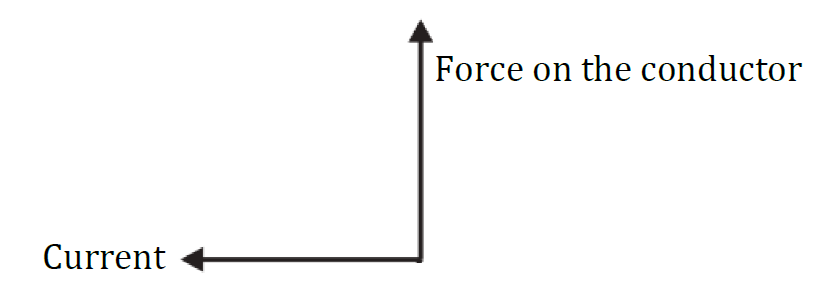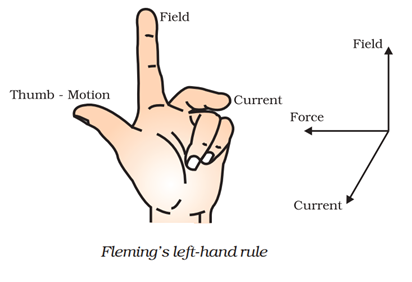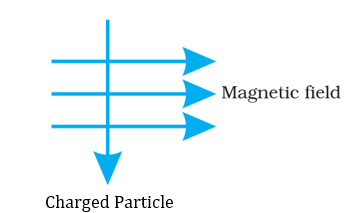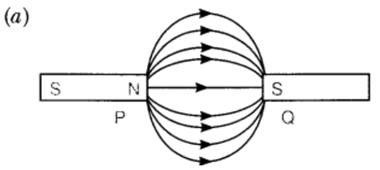Extra Questions for Class 10 Science Chapter 13 Magnetic Effect of Electric Current
Get extra questions for Class 10 Science Chapter 13 Magnetic Effect of Electric Current with PDF. Our subject expert prepared these solutions as per the latest NCERT textbook. These extra questions will be helpful to revise the important topics and concepts. You can easily download all the questions and answers in PDF format from our app.
Magnetic Effect of Electric Current Class 10 Science Extra Questions with Answers
Question 1: Name the type of current:
(a) used in household supply.
(b) given by a cell.
Answer:
(a) Alternating current.
(b) Direct current.
Question 2: State the direction of magnetic field in the following case.

Question 3: Name the physical quantities which are indicated by the direction of thumb and forefinger in the Fleming’s right hand rule?
Answer: In Fleming’s right hand rule, thumb indicates — direction of motion of the conductor; forefinger indicates — direction of magnetic field.

Question 4: A positively charged particle (alpha-particle) projected towards west is deflected towards north by a magnetic field. The direction of magnetic field is
(a) towards north
(b) towards east
(c) downward
(d) upward
Answer: (d) Upward (Apply Fleming’s left hand rule).
Question 5: A charged particle enters at right angle into a uniform magnetic field as shown. What should be the nature of charge on the particle if it begins to move in a direction pointing vertically out of the page due to its interaction with the magnetic field?

Answer: Using Fleming’s left hand rule, the nature of charged particle is positive.
Question 6: Name any two appliances which are based on the application of heating effect of electric current.
Answer: Room heater and geyser.
Question 7: Why and when does a current carrying conductor kept in a magnetic field experience force? List the factors on which direction of this force depends?
Answer: The drifting of free electrons of a conductor in a definite direction causes the current to flow through it. When such conductor is placed in a uniform magnetic field, each drifted electron of a conductor experience a magnetic force. This force is collectively experience by a conductor as a whole. Hence a current carrying conductor kept in a magnetic field experience a force. The direction of magnetic force depends on
(i) direction of current through the conductor, and
(ii) direction of magnetic field.
Question 8: How is the strength of magnetic field near a straight current-conductor
(i) related to the strength of current in the conductor?
(ii) is affected by changing the direction of flow of current in the conductor?
Answer: (i) The strength of magnetic field around a straight current conductor increases on increasing the strength of current in the conductor or vice versa.
(ii) The direction of magnetic field around a straight current carrying conductor gets reversed if the direction of current through that conductor is reversed.
Question 9: What is meant by the term ‘frequency of an alternating current’? What is its value in India? Why is an alternating current considered to be advantageous over direct current for long range transmission of electric energy?
Answer: Frequency of Alternating current is equal to the number of cycles completed in one second. In India, frequency of AC is 50 Hz i.e. 50 cycles per second.
An alternating current is considered to be advantageous over direct current for long range transmission of electric energy because it can be transmitted over long distances to distant places without much loss of electric power as compared to direct current.
Question 10: Explain any two situations that can cause electrical hazards in domestic circuits.
Answer: (i) Connecting too many electrical devices to a single socket or in the extension cord for any length of time draws high current from the mains that will exceed the current rating of connecting wires. The wires cannot withstand such a high current and melt and may cause fire.
(ii) Most electrical hazards in domestic circuits are caused by the faulty electrical outlets, old and out-dated appliances. The chances of short circuit i.e., contact of live wire and neutral wires with each other due to damage in their insulation or some fault in the appliances are very high. It may result spark at the contact point which may even cause fire,
Question 11: List major differences between an electric motor and a generator.
Answer:
| Differentiating Property | Motor | Generator |
| Definition | An electric motor is a machine that converts electrical energy to mechanical energy. | An electric generator is a machine that converts mechanical energy to electrical energy. |
| Rule | Electric motor follows Fleming’s left-hand rule. | Electric generator follows Fleming’s right-hand rule. |
| Principle | The working principle of a motor is based on the current-carrying conductor that experiences a force when it is kept in the magnetic field. | The working principle of generator is based on electromagnetic induction. |
| Driving force for shaft | The shaft of an electric motor is driven by a magnetic force which is developed between the armature and field. | The shaft of an electric generator is connected to the rotor which is driven by a mechanical force. |
| Current Usage | In a motor, current is supplied to the armature winding. | In a generator, current is produced in the armature winding. |
| Example | Ceiling fans, cars, etc. are all examples of motor. | In power stations, generator is used to generate electricity. |
Question 12: The given magnet is divided into three parts A, B, and C.
Name the parts where the strength of the magnetic field is: (i) maximum (ii) minimum.
How will the density of magnetic field lines differ at these parts?
| A | B | C |
Answer: (i) Maximum strength – at A and C
(ii) Minimum strength – at B
At A and C, magnetic field lines are crowded while at B, they are spread out.
Question 13: A compass needle is placed near a current-carrying wire. State your observation for the following cases, and give reason for the same in each case.
(a) Magnitude of electric current in the wire is increased.
(b) The compass needle is displaced away from the wire.
Answer: (a) Observation: The deflection of the needle increases.
Reason: Magnetic field strength due to current-carrying wire increases as current in the wire increases, B ∝ I
(b) Observation: The deflection in the compass needle decreases as its displacement from the current carrying wire increases.
Reason: The strength of magnetic field reduces with the increase in distance from the wire as B ∝ I/r.
Question 14: (a) Two magnets are lying side by side as shown below.
Draw magnetic field lines between poles P and Q.

(b) What does the degree of closeness of magnetic field lines near the poles signify?
Answer:

(b) The degree of closeness of magnetic field lines near the poles signify that the field is stronger there, i.e. the pole of another magnet when placed in the magnetic field experiences a greater force where the field lines are crowded.
Question 15: Magnetic field lines of two magnets are shown in fig. A and fig. B.

Select the figure that represents the correct pattern of field lines. Give reasons for your answer. Also name the poles of the magnets facing each other.
Answer: Figure B represents the correct pattern of field lines. In figure A, field lines cross each other which is not possible because if they cross each other, at the point of intersection, there would be two directions of field lines.
In figure B, field lines are emerging in nature, so poles of magnet facing each other are north poles while opposite faces will have south polarity.
Question 16: Insulation cover of which colour is conventionally used for earth wire? Why is an earth wire connected to metallic parts of appliances?
Answer: For earth wire, green or yellow colour insulation is used. The earth wire provides the low resistance conducting path for the current and maintains the potential of appliances body with that of the earth. So, earth wire is used as a safety measure.
Question 17: Identify the poles of the magnet in the given figure (1) and (2).

Answer: Field lines emerge from north pole (N) and merge at the south pole (S) as shown in both the figures

Question 18: Explain the role of fuse in series with any electrical appliance in an electric circuit. Why should a fuse with defined rating for an electric circuit not be replaced by one with a larger rating?
Answer: Fuse is a safety device connected in series with live wire or with any electrical appliance in an electric circuit. It stops the flow of unduly high electric current in the circuit by getting melted due to rise in temperature as per Joule’s law of heating.
High rating fuse wire has the larger capacity. So, it will not stop the flow of any relatively high current. Therefore, electrical devices cannot be protected from the possible damage.
Question 19: The magnetic field associated with a current-carrying straight conductor is in anticlockwise direction. If the conductor was held along the east-west direction, what will be the direction of current through it? Name and state the rule applied to determine the direction of current.
Answer: Direction of current – east to west as determined by Right-hand thumb rule. Ri’-lu-Uand Thumb
Rule: If we hold a current-carrying conductor by right hand in such a way that the stretched thumb is along the direction of current, then the curly fingers around the conductor represents the direction of field lines of magnetic field.
Question 20: Two circular coils A and B are placed close to each other. If the current in the coil A is changed, will some current be induced in the coil B? Give reason.
Answer: Yes, when a current in coil A changes, magnetic field lines linked with coil B also change. Hence, due to change in number of magnetic field lines, there is an induced current in coil B.
Question 21: When is the force experienced by a current-carrying conductor placed in a magnetic field largest?
Answer: When the length of current-carrying conductor and direction of magnetic field are perpendicular to each other, the maximum force is experienced by the current-carrying conductor.
Question 22: State one main difference between A.C and D.C. Why A.C is preferred over D.C for long range transmission of electric power? Name one source each of D.C and A.C.
Answer: Difference between A.C. and D.C. The alternating current (A.C.) reverses its direction periodically whereas the direct current (D.C.) always flows in one direction.
A.C. is preferred over D.C. because it can be transmitted over long distance without much loss of energy.
D.C. source: Battery
A.C. source: A.C. generator
Question 23: State the consequences that can lead to a short circuit. (or)
One of the major cause of fire in office building is short circuiting. List three factors which may lead to the short circuit.
Answer: It occurs as a consequence of
- failure of electrical insulation’s due to which live wire comes in direct contact with neutral or earth wire.
- presence of external conducting material such as water which is introduced accidentally into the circuit.
- electrical appliances are forced to operate when its moving parts are jammed.
- connection of current carrying parts of electrical equipment’s comes in contact to one another due to human or natural cause and use of less rating wires.
- When this happens, there is an excessive electric current which can damage the circuit and may also cause electrical fires.
Question 24: What is short circuiting? State one factor/condition that can lead to it. Name a device in the household that acts as a safety measure for it. State the principle of its working.
Answer: Short circuiting: When electric circuit offers very low resistance to the flow of current through it, the current increases heavily and the circuit is said to be short circuited. It occurs when live wire touches the neutral wire. This happens due to the damage in insulation of the power lines.
Safety measure device: Fuse.
Working principle of fuse: It works on the heating effect of electric current or Joule’s law of heating.
According to this law, the heat produced in a resistor is directly proportional to the
(i) square of current for a given resistance.
(ii) resistance for a given current and
(iii) time for which the current flows through the resistor.
We know, H = I2Rt
So, when current in the circuit increases, the wire with low melting point in it melts to the heat generated.
Hence, the circuit breaks and electrical devices and appliances are saved. _
Question 25: Write one application of each of the following:
(a) Right-hand thumb rule
(b) Fleming’s left hand rule
(c) Fleming’s right hand rule
Answer: (a) Right-hand thumb rule is used to find the direction of magnetic field in a coil of wire and the electric current in a straight conductor.
(b) Fleming’s left hand rule is used to find the direction of force exerted on a current carrying conductor placed in a magnetic field as in electric motor.
(c) Fleming’s right hand rule is used to find the direction of induced current in a closed circuit placed in changing magnetic field as in electric generator.
Question 26: State one main difference between A.C. and D.C. Why is A.C. preferred over D.C. for long range transmission of electric power? Name one source each of D.C. and A.C.
Answer: Difference between A.C. and D.C.: The alternating current (A.C.) reverses its direction periodically whereas the direct current (D.C.) always flows in one direction.
A.C. is preferred over D.C. because it can be transmitted over long distance without much loss of energy.
D.C. source: Battery A.C. source: A.C. generator
Question 27: What is meant by solenoid? How does a current carrying solenoid behave? Give its main use.
Answer: Solenoid: A coil of many circular turns of insulated copper wire wound on a cylindrical insulating body (i.e., cardboard etc.) such that its length is greater than its diameter is called solenoid.
When current is flowing through the solenoid, the magnetic field line pattern resembles exactly with those of a bar magnet with the fixed polarity, i.e. North and South pole at its ends and it acquires the directive and attractive properties similar to bar magnet. Hence, the current carrying solenoid behave as a bar magnet.
Use of current carrying solenoid: It is used to form a temporary magnet called electromagnet as well as permanent magnet.
Question 28: What are magnetic field lines? Justify the following statements
(a) Two magnetic field lines never intersect each other.
(b) Magnetic field lines are closed curves.
Answer: Magnetic field lines: It is defined as the path along which the unit North pole (imaginary) tends to move in a magnetic field if free to do so.
(a) The magnetic lines of force do not intersect (or cross) one another. If they do so then at the point of intersection, two tangents can be drawn at that point which indicates that there will be two different directions of the same magnetic which field, i.e. the compass needle points in two different directions which is not possible.
(b) Magnetic field lines are closed continuous curves. They diverge from the north pole of a bar magnet and converge its south pole. Inside the magnet they move from south pole to north pole.